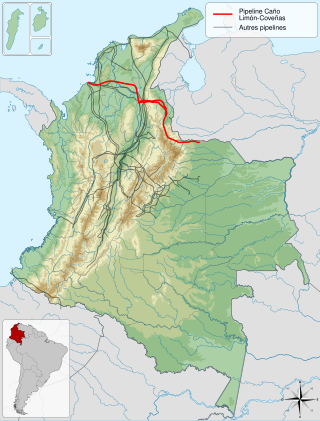
Gulf Oil was a major global oil company in operation from 1901 to 1985. The eighth-largest American manufacturing company in 1941 and the ninth-largest in 1979, Gulf Oil was one of the so-called Seven Sisters oil companies. Prior to its merger with Standard Oil of California, Gulf was one of the chief instruments of the Mellon family fortune; both Gulf and Mellon Financial had their headquarters in Pittsburgh, Pennsylvania, with Gulf's headquarters, the Gulf Tower, being Pittsburgh's tallest building until the completion of the U.S. Steel Tower.
Texaco, Inc. is an American oil brand owned and operated by Chevron Corporation. Its flagship product is its fuel "Texaco with Techron". It also owned the Havoline motor oil brand. Texaco was an independent company until its refining operations merged into Chevron, at which time most of its station franchises were divested to Shell plc through its American division.

Chevron Corporation is an American multinational energy corporation predominantly in oil and gas. The second-largest direct descendant of Standard Oil, and originally known as the Standard Oil Company of California, it is headquartered in San Ramon, California, and active in more than 180 countries. Within oil and gas, Chevron is vertical integrated and is involved in hydrocarbon exploration, production, refining, marketing and transport, chemicals manufacturing and sales, and power generation.

The Caño Limón – Coveñas pipeline is a crude oil pipeline in Colombia from the Caño Limón oilfield in the municipalities of Arauca and Arauquita in Arauca Department on the border of Venezuela to Coveñas on Colombia's Caribbean coastline. It is jointly owned by the state oil firm Ecopetrol, and U.S. company Occidental Petroleum. The pipeline is 780 kilometres (480 mi) long.
The Rumaila oil field is a super-giant oil field located in southern Iraq, approximately 20 mi (32 km) from the Kuwaiti border. Discovered in 1953 by the Basrah Petroleum Company (BPC), an associate company of the Iraq Petroleum Company (IPC), the field is estimated to contain 17 billion barrels, which accounts for 12% of Iraq's oil reserves estimated at 143.1 billion barrels. Rumaila is said to be the largest oilfield ever discovered in Iraq and is considered the third largest oil field in the world.

The Iraq Petroleum Company (IPC), formerly known as the Turkish Petroleum Company (TPC), is an oil company that had a virtual monopoly on all oil exploration and production in Iraq between 1925 and 1961. It is jointly owned by some of the world's largest oil companies and headquartered in London, England, although today it is only a paper entity with historical rights and plays no part in the modern development of Middle Eastern oil.

EP Petroecuador is the national oil company of Ecuador. Ecuador who is a member of the Organization of the Petroleum Exporting Countries (OPEC) and, although it is the smallest member, the country produced 531,000 barrels of crude oil per day in 2019. The oil corporation is a significant part of the Ecuadorian economy. The petroleum industry has expanded to the production of refined commodities such as gasoline, liquefied petroleum, and jet fuel. The government of Ecuador is highly dependent on the revenues from the energy sector to support its budget and finance state projects.
For further details see the "Energy crisis" series by Facts on File.

Ecopetrol, formerly known as Empresa Colombiana de Petróleos S.A. is the largest and primary petroleum company in Colombia. As a result of its continuous growth, Ecopetrol forms part of the Fortune Global 500 and was ranked 346. In the 2020 Forbes Global 2000, Ecopetrol was ranked as the 313th -largest public company in the world. It was ranked 303 in 2012 by CNN Money. The company belongs to the group of 25 largest petroleum companies in the world, and it is one of the four principal petroleum companies in Latin America.
The Caño Limón oilfield is an oil field crude oil in Arauca Department, Colombia. It is Colombia's second-largest oil field.

The Ocensa pipeline is a crude oil pipeline in Colombia. It starts on the Cusiana and Cupiagua oilfields and runs to Coveñas on Colombia's Caribbean coastline. It is owned by the consortium of Ecopetrol, BP, Total S.A., Petrominerales and Triton Colombia.

Frontera Energy is a Canadian petroleum exploration and production company in the business of heavy crude oil and natural gas. Its focus is on Colombia and Peru where it holds numerous properties including 38 blocks in the Llanos, Sucre-Co Lower Magdalena and Cesar Valley, Rancheria, Upper and Middle Magdalena Valley, Putumayo Valley, Ucayali and Maranon basins. In early 2010 it was the largest independent oil company operating in South America and in terms of private companies the fastest growing one in Colombia. In 2011 it was responsible for 41% of the growth in oil production in Colombia. In mid-2015 it changed its name from Pacific Rubiales to Pacific Exploration and Production, signalling the diminished importance of the Rubiales oil field in Colombia in the company's total assets and a broader focus in Latin America. When Pacific Exploration and Production filed for bankruptcy protection on April 27, 2016, it listed Pacific E&P Holdings Corp., Meta Petroleum Corp., Pacific Stratus International Energy Ltd., Pacific Stratus Energy Colombia Corp., Pacific Stratus Energy S.A., Pacific Off Shore Peru S.R.L., Pacific Rubiales Guatemala S.A., Pacific Guatemala Energy Corp., PRE-PSIE Coöperatief U.A., Petrominerales Colombia Corp. and Grupo C&C Energia (Barbados) Ltd. as subsidiaries. In June 2017, it renamed itself Frontera Energy, and was relisted on the Toronto Stock Exchange.

The Bahrain Petroleum Company (BAPCO) is an integrated national oil company of Bahrain.
The petroleum industry in Colombia is an important contributor to the country's economy.
The Pan American Petroleum and Transport Company (PAT) was an oil company founded in 1916 by the American oil tycoon Edward L. Doheny after he had made a huge oil strike in Mexico. Pan American profited from fuel demand during World War I, and from the subsequent growth in use of automobiles. For several years Pan American was the largest American oil company, with holdings in the United States, Mexico, Colombia and Venezuela. In 1924 Pan American was involved in the Teapot Dome scandal over irregularities in the award of a U.S. government oil concession. Standard Oil of Indiana obtained a majority stake in 1925. The company sold its foreign properties to Standard Oil of New Jersey in 1932. What was left of Pan American was merged with Standard Oil of Indiana in 1954 to form Amoco.
Lago Petroleum Corporation was an oil production company established by Americans in 1923 that exploited the oilfields in Lake Maracaibo. It was acquired by Standard Oil of New Jersey in 1932. Later it was nationalized.

Torkild Rieber was a Norwegian immigrant to the United States who became chairman of the Texas Company (Texaco).
The Standard Vacuum Oil Company was an American joint venture by Standard Oil of New Jersey and Socony-Vacuum Oil established in 1931 to make and market products in the Far East. Around World War I, the market in the Far East was too large to leave unattended, but still small.












